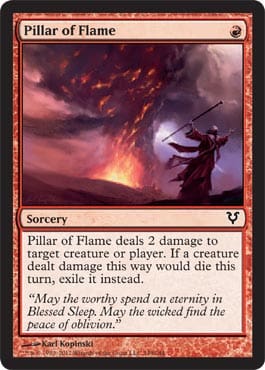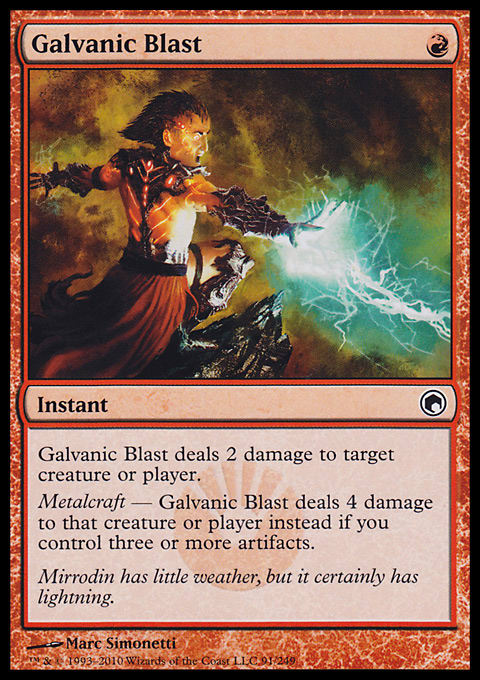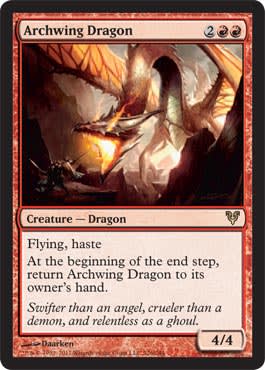With the addition of Avacyn Restored to the Standard format, I decided it was time for a new Standard deck better suited to the current environment. As usual, I want to win, and I don’t want to break the bank to do it. So, I decided it was time for another good Standard deck for under $100. As you may know, in these situations, I usually look for aggressive mono-colored decks that don’t need mythic rares in order for them to kick butt.
In this case, I’ve decided to go red. My previous Standard deck had been a mostly mono-white token deck. However, not only does everyone seem to be playing with Ratchet Bombs now, but I don’t feel that Avacyn Restored has really brought much to the table to help improve the deck. I tried playing it with Angel of Jubilation in a couple events, and while it’s a solid card in the deck, I didn’t feel that it made the deck significantly better than it already was, and I sideboarded them out frequently.
Red, however, has all sorts of new presents it’s received in Avacyn Restored: Pillar of Flame, Bonfire of the Damned, Archwing Dragon, Vexing Devil, Stonewright, Dangerous Wager, Lightning Mauler, Thunderbolt, Fervent Cathar, Zealous Conscripts, and Thunderous Wrath. But which ones to use? There are many elements I’m looking for in an aggressive red deck:
- At least one good first-turn threat. Previously, this was Goblin Guide, and currently, this is Stromkirk Noble.
- Persistent, resilient damage sources. Chandra's Phoenix is a great example of this. It can hit as early as turn three, it’s hard to block, and I can bring it back from the graveyard when it dies.
- High-quality, cost-efficient burn. While I miss spectacular burn spells such as Lightning Bolt, Burst Lightning, Chain Lightning, and Fireblast, there are still some good ones available—like Incinerate.
- Ways to make good use of my mana if I start to mana flood. Previously, I had a lot of cards that liked it when I drew a few extra lands: Kargan Dragonlord, Plated Geopede, Burst Lightning, and Chandra's Phoenix. While many of these are gone, there are still many cards that might be worth pumping mana into: Devil's Play, Phoenix, Archwing Dragon, Shrine of Burning Rage, and so on.
The first thing I do when designing a deck is decide what the core elements should be. These are typically cards that are so powerful that I really want to find a deck to play them in and that work really well together.
In this case, the core cards I want to build around are Stromkirk Noble, Shrine of Burning Rage, and Chandra's Phoenix. Stromkirk Noble is the best red 1-drop with 2 powerful abilities. Shrine is a powerful game-ender in mono-red that’s cheap enough to get around permission. The Phoenix is constant, fast, durable pressure that rewards you for playing with a lot of burn. All three reward you for playing mono-colored. You’ll always have the right color on turn one for your Noble, all of your spells will pump up your Shrines, and not only does Phoenix require
Stromkirk Noble $4 × 4 = $16
Chandra's Phoenix $5.25 × 4 = $21
Shrine of Burning Rage $2 × 4 = $8
Running Total: $45 – 12 cards.
Ouch. Close to half of our budget with only twelve cards. That’s okay—not only are they key components, but much of the deck will be really inexpensive burn spells and basic Mountains. All three of the core cards reward you for playing a lot of burn.
The Noble likes you to remove potential blockers. The Phoenix is retrieved by burn. Not only does the Shrine receive counters when you play burn, but burn with Shrines will sometimes be enough to kill your opponent even if you’re unable to ever hit him with creatures.
So, what are the best burn options? This is primarily about the damage-to-mana ratio. The obvious champ in this category is Incinerate, at 3 damage for 2 mana, unlike Brimstone Volley and Volt Charge, which do 3 for 3. Gut Shot can do 1 for 2, but I generally find it to be too weak, especially in a deck that actually has the red mana to play it normally whereas I can pay 1 mana for twice as much damage in many forms: Shock, Galvanic Blast, and Pillar of Flame. I like Devil's Play in this deck for several reasons:
- Flexible cost – I can kill a 1-drop on turn two, but I can kill a Titan in the late game or better yet, hit my opponent in the dome for a huge chunk of finishing damage.
- Flashback – Not only can I use it twice to put multiple counters on Shrine, retrieve a Phoenix multiple times, and/or kill multiple creatures, but it has a flashback cost well suited to a mono-red deck.
- Mana hogging – This is great way to compensate me for being mana flooded. Not only is it an X spell, but it’s two X spells for one card.
Pillar of Flame $.25 × 4 = $1
Shock $.10 × 4 = $.40
Galvanic Blast $.5 × 4 = $.20
Incinerate $.25 × 4 = $1
Devil's Play $1 × 4 = $4
Running Total: $45 + $6.60 = $51.60 – 32 cards
At this point, not only am I only running twelve cards designed to put my opponent in range of finishing burn—Phoenix, Shrine, and Noble—but given the high number of 1-mana burn spells, the deck is in danger of not having a good enough late game. While a card like Shock is an amazing use of 1 mana, it seems pretty lame when you have 6 mana available.
Archwing Dragon is a perfect fit here. It gives me a powerful tool for quickly knocking my opponent’s life total down into easy burn range. It also gives me a powerful use for what would otherwise be excess mana in the late game.
Archwing Dragon $1 × 4 = $4
Running Total: $51.60 + $4 = $55.60 – 36 cards
This leaves us room for twenty-four lands. While this is much higher than RDW uses in the current metagame—the one that made Top 32 in Providence recently only played twenty lands, for example—it’s because this isn’t actually RDW. Chris’s decklist from Providence included twenty creatures, seventeen of which cost 2 mana or less.
He had five spells he could play for 0 mana and nothing more than 3 to cast, and there were only three of those—unless you’re counting his two Thunderous Wraths as 6-mana spells. While obviously RDW is faster than “Red Kastle” (I guess this makes my last deck “White Kastle,” but this deck heats things up better), it has weaknesses that Red Kastle doesn’t.
Mana screw – I don’t care how low your curve is; with twenty lands, you’re going to be mana screwed . . . a lot. Cards such as Shrine and Phoenix require you to make it to at least 3 mana and in a timely fashion—something I don’t want to depend on twenty lands for.
Mana flood – If for some reason the RDW player does draw a lot of lands, his deck is suddenly a ninety-eight-pound weakling like Steve Rogers was in the beginning of Captain America. If you have a lot of lands, and the only spells you drew were a couple 1-drops and a Gut Shot, you’re going to be in big trouble.
Mana efficiency is the beauty of Red Kastle. In the early game, I have twenty-eight cards that can be played for 2 or less mana. With twenty-four lands, I’m unlikely to become mana screwed. Yet, if I draw a number of lands that might doom RDW to being horribly mana flooded, I have four Dragons and four Devil's Plays in addition to my Phoenixes and Shrines to give me powerful things to do with what otherwise would have been excess mana. My deck is never a ninety-eigh-pound weakling; it’s always in super-soldier mode.
Mountains $.10 × 24 = $2.40
Running Total: $55.60 + $2.40 = $58 – 60 cards
Of course, before I move on to creating the sideboard, I need to answer your burning question: What about Vexing Devil and Thunderous Wrath? My first version of this deck had both of these cards. This was in part because my local card shop couldn’t find me Galvanic Blasts, but I wanted to test these cards anyways.
I don’t like Vexing Devil. On turn one, it’s like my opponent paid 4 life for me to mulligan and not play anything on turn one. In the late game, my opponent can often let me have a 4/3 ground creature with no special ability, and it won’t be relevant. It doesn’t synergize with Phoenix, and it rarely lets me interact with my opponent in a way that I’m happy with. There were a couple games in which drawing one early directly contributed to a quick win, but the unpredictability of its usefulness is definitely not my style.
I do like Thunderous Wrath—just not enough for it to make the cut. I hold the cards in my Constructed decks to a rigorous standard, as I mentioned last week in Maxing Out, and this doesn’t quite make it. While the miracle ability is pretty awesome, I need to have a big creature to kill already in play or to be in the finish-my-opponent-off-with-burn portion of the game for it to be better than a Shock. While I can make it to 6 mana with this deck, I hate having my hand cluttered with cards that I have to wait that long just to have the option of using. By removing the Wraths and the Devils from the deck, it allows me to plan ahead and control the flow of the game better.
With $42 left, things are looking pretty good as we move to sideboard creation. This is a bit deceiving since some of the best red sideboard cards are rares or mythic rares—Manabarbs, Slagstorm, and Bonfire of the Damned. Since I’m not running a deck as cheap or fast as RDW, Manabarbs isn’t a great fit, but the other two are.
Bonfire benefits from my having twenty-four lands, and Slagstorm rewards me for not being a weenie deck as RDW is. First, I want four Manic Vandals, though. I quickly learned I wanted to bring them in against every opponent; among other things, if an opponent doesn’t have any artifacts, he probably isn’t going to beat me anyway. I blew up a lot of major problem cards: Sword of War and Peace, Batterskull, and Birthing Pod. I also want an answer to big creatures such as Titans, so I chose Traitorous Blood. Dismember is generally powerful and efficient removal, and it’s an answer to pro-red creatures.
Slagstorm $4.25 × 4 = $17
Bonfire of the Damned $16.25 × 1 = $16.25
Traitorous Blood $.10 × 3 = $.30
Manic Vandal $.10 × 4 = $.40
Dismember $2 × 3= $6
Running Total: $58 + $39.95 = $97.95 – 75 cards
This fits us nicely under the $100 salary cap while leaving us with an excellent deck that I consider Tier 1. That’s of course the point of this exercise. If I can’t make a Tier 1 budget deck, what’s the point of building or playing it? It’s not as though I designed it to be the most fun deck to play; it’s designed purely to win games.
"Red Kastle"
- Creatures (12)
- 4 Archwing Dragon
- 4 Chandra's Phoenix
- 4 Stromkirk Noble
- Spells (24)
- 4 Galvanic Blast
- 4 Incinerate
- 4 Shock
- 4 Devil's Play
- 4 Pillar of Flame
- 4 Shrine of Burning Rage
- Lands (24)
- 24 Mountain
- Sideboard (15)
- 4 Slagstorm
- 1 Bonfire of the Damned
- 3 Traitorous Blood
- 4 Manic Vandal
- 3 Dismember
The most frequently asked question the last time I made a deck with a $100 cap was: What cards would I include if I were making it without a cap? “White Kastle” didn’t require any more expensive cards even had I been willing to spend the money. In this case, ideally, I’d have a couple more Bonfires in the sideboard, but $16 is a lot to pay for a non-vital sideboard card. This is a good example of why I try to find archetypes that don’t require mythic rares to be Tier 1.
I’ll being serving up some Red Kastle at FNM, and I’ll let you know how it goes. Thanks for reading.




























